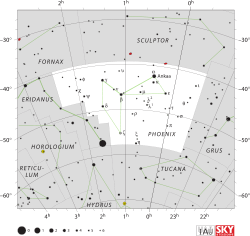Alpha Phoenicis

| |
| Observation data Epoch J2000 Equinox J2000 | |
|---|---|
| Constellation | Phoenix |
| Right ascension | 00h 26m 17.05140s[1] |
| Declination | –42° 18′ 21.5539″[1] |
| Apparent magnitude (V) | 2.377[2] |
| Characteristics | |
| Spectral type | K0.5 IIIb[3] |
| U−B color index | +0.903[2] |
| B−V color index | +1.092[2] |
| Astrometry | |
| Radial velocity (Rv) | +74.6[4] km/s |
| Proper motion (μ) | RA: +233.05[1] mas/yr Dec.: –356.30[1] mas/yr |
| Parallax (π) | 38.50 ± 0.73[1] mas |
| Distance | 85 ± 2 ly (26.0 ± 0.5 pc) |
| Orbit[5] | |
| Period (P) | 3848.8 days |
| Semi-major axis (a) | 103.5 m |
| Eccentricity (e) | 0.34 |
| Inclination (i) | 128.0 ± 5.4° |
| Longitude of the node (Ω) | 242.8 ± 3.9° |
| Periastron epoch (T) | 2416201.8 HJD |
| Argument of periastron (ω) (primary) | 19.8° |
| Details | |
| Radius | 15[6] R☉ |
| Surface gravity (log g) | 2.53[3] cgs |
| Temperature | 4,436[3] K |
| Metallicity [Fe/H] | –0.73[3] dex |
| Other designations | |
Alpha Phoenicis (α Phoenicis, abbreviated Alpha Phe or α Phe), also named Ankaa,[8] is the brightest star in the constellation of Phoenix.
Nomenclature
Alpha Phoenicis is the star's Bayer designation. It also bore the traditional name Ankaa sometime after 1800, from the Arabic العنقاء al-ʿanqā’ "the phoenix" for the name of the constellation.[9] Medieval Arab astronomers formed the constellation of the dhow (where Phoenix is), so another popular name for the star is Nair al Zaurak[10] from نائر الزوق na’ir az-zawraq "the bright (star) of the skiff". The Latin translation is Cymbae, from lūcida cumbae.[10] In 2016, the International Astronomical Union organized a Working Group on Star Names (WGSN)[11] to catalog and standardize proper names for stars. The WGSN's first bulletin of July 2016[12] included a table of the first two batches of names approved by the WGSN; which included Ankaa for this star.
Description
This is a spectroscopic binary star system with components that orbit each other every 3848.8 days (10.5 years).[5] The combined stellar classification of the system is K0.5 IIIb,[3] which matches the spectrum of a lower luminosity giant star. It has an apparent visual magnitude of 2.4,[2] so it is somewhat outshone by its first magnitude neighbors Achernar (α Eridani) and Fomalhaut (α Piscis Australis). Based upon parallax measurements, this system is at a distance of about 85 light-years (26 parsecs) from the Earth.[1] The interferometry-measured angular diameter of the primary component, after correcting for limb darkening, is 5.25 ± 0.06 mas,[13] which, at its estimated distance, equates to a physical radius of about 15 times the radius of the Sun.[6]
Ankaa is similar to many of the visible stars of the night sky, being an orange giant of relatively average stellar size. It is currently thought to be in the midst of a short but stable helium burning phase of its stellar evolution, although it probably will not be long in astronomical terms before it sheds its outer layers as a planetary nebula and ends its life quietly as a white dwarf. Ankaa has a small stellar companion, about which little is known.
References
- 1 2 3 4 5 6 van Leeuwen, F. (November 2007), "Validation of the new Hipparcos reduction", Astronomy and Astrophysics, 474 (2): 653–664, arXiv:0708.1752
 , Bibcode:2007A&A...474..653V, doi:10.1051/0004-6361:20078357
, Bibcode:2007A&A...474..653V, doi:10.1051/0004-6361:20078357 - 1 2 3 4 Gutierrez-Moreno, Adelina; et al. (1966), A System of photometric standards, 1, Publicaciones Universidad de Chile, Department de Astronomy, pp. 1–17, Bibcode:1966PDAUC...1....1G
- 1 2 3 4 5 Gray, R. O.; et al. (July 2006), "Contributions to the Nearby Stars (NStars) Project: Spectroscopy of Stars Earlier than M0 within 40 pc-The Southern Sample", The Astronomical Journal, 132 (1): 161–170, arXiv:astro-ph/0603770
 , Bibcode:2006AJ....132..161G, doi:10.1086/504637
, Bibcode:2006AJ....132..161G, doi:10.1086/504637 - ↑ Evans, D. S. (June 20–24, 1966), Batten, Alan Henry; Heard, John Frederick, eds., The Revision of the General Catalogue of Radial Velocities, University of Toronto: International Astronomical Union, retrieved 2009-09-10
- 1 2 Jancart, S.; et al. (October 2005), "Astrometric orbits of SB^9 stars", Astronomy and Astrophysics, 442 (1): 365–380, arXiv:astro-ph/0507695
 , Bibcode:2005A&A...442..365J, doi:10.1051/0004-6361:20053003
, Bibcode:2005A&A...442..365J, doi:10.1051/0004-6361:20053003 - 1 2 Lang, Kenneth R. (2006), Astrophysical formulae, Astronomy and astrophysics library, 1 (3rd ed.), Birkhäuser, ISBN 3-540-29692-1. The radius (R*) is given by:
- ↑ "alf Phe -- Spectroscopic binary", SIMBAD, Centre de Données astronomiques de Strasbourg, retrieved 2012-01-09
- ↑ "IAU Catalog of Star Names". Retrieved 28 July 2016.
- ↑ Kunitsch, Paul; Smart, Tim (2006). A Dictionary of Modern Star names: A Short Guide to 254 Star Names and Their Derivations. Cambridge, Massachusetts: Sky Publishing Corp. p. 49. ISBN 978-1-931559-44-7.
- 1 2 Allen, Richard Hinckley (1899), Star-names and their meanings, G. E. Stechert, p. 336
- ↑ "IAU Working Group on Star Names (WGSN)". Retrieved 22 May 2016.
- ↑ "Bulletin of the IAU Working Group on Star Names, No. 1" (PDF). Retrieved 28 July 2016.
- ↑ Richichi, A.; Percheron, I.; Khristoforova, M. (February 2005), "CHARM2: An updated Catalog of High Angular Resolution Measurements", Astronomy and Astrophysics, 431: 773–777, Bibcode:2005A&A...431..773R, doi:10.1051/0004-6361:20042039